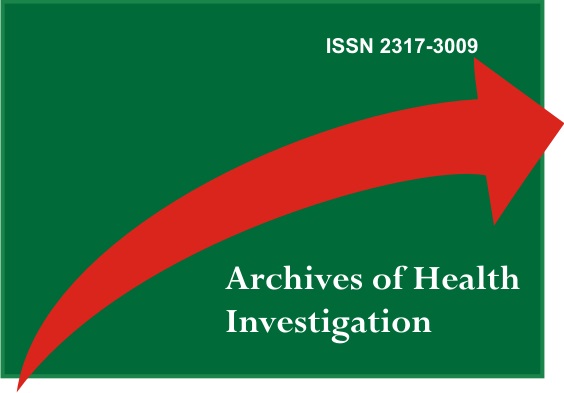Benign migratory glossitis in preschool children
DOI:
https://doi.org/10.21270/archi.v10i5.5036Keywords:
Glossitis, Benign Migratory, Child, Preschool, Pediatric DentistryAbstract
Benign migratory glossitis (BMG), also known as geographic tongue (GT) or migratory erythema (ME), is a common benign oral condition of unknown etiology, but with psychosomatic, immunological, infectious and nutritional factors believed to be associated. It affects exclusively the tongue and it is marked by erosive migratory areas, isolated or multiple. This study aims to analyze the presence of this pathology in preschool age children, as well as to clarify its pathophysiological aspects. Scientific articles selected through the Google Scholar, Scientific Eletronic Library Online (SciELO) and Portal Regional da Biblioteca Virtual em Saúde (BVS) platforms were analyzed. The search on the platforms happened through the MeSH descriptors: Benign migratory glossitis; Geographic Tongue; Preschoolers; Pediatric Dentistry.This condition has a multiform clinical aspect, highlighting the presence of erythematous erosive lesions with irregular withish/grayish edges, reminiscing the contours of a geographic map that, after regression, may return to the same place or to different areas, what gives the migratory aspect. Therefore, it is a benign anomaly that occurs mainly in early childhood, and its morphology is quite varied and without significant evidence that there is a predilection for sex. Treatment is nonspecific and appropriate to the symptoms.
Downloads
References
Santos KSS, Monezi LLL, Caldas LTS. Glossite migratória benigna em paciente pediátrico: Relato de caso. Rev Odontol Araçatuba. 2018;9(3):39-42.
Scariot R, Batista TBD, Olandoski M. Host and clinical aspects in patients with benign migratory glossitis. Arch Oral Biol. 2017;73:259-68.
Prinz H. Wandering Rash of the Tongue (Geographical Tongue). Dental Cosmos. 1927; 69:272-75.
Carvalho FVQ, Trigueiro M, Mangueira DRB. Glossite migratória benigna ou língua geográfica: relato de caso clínico. Int J Dent. 2010;9(3):165-68.
Nandini DB. Paediatric Geographic Tongue: a case report, review and recent updates. J Clin Diagn Res. 2016;10(2):5-9.
Hooda A, Rathee M, Gulia J, Yadav S. Benign migratory glossitis: a review. Int J Family Pract. 2011;9(2):1-7.
Assimakopoulos D, Patrikakos G, Fotika C, Elisaf M. Benign migratory glossitis or geographic tongue: an enigmatic oral lesion: an enigmatic oral lesion. Am J Med. 2002; 113(9):751-55.
Shareef S, Ettefagh L. Geographic Tongue. 2020. In: StatPearls [Internet]. Treasure Island (FL): StatPearls Publishing; 2021.
Picciani B, Santos VC, Teixeira-Souza T, Izahias LM, Curty A, Avelleira JC et al. Investigation of the clinical features of geographic tongue: unveiling its relationship with oral psoriasis. Int J Dermatol. 2017;56(4):421-27.
Pérez FH, Aveldañez AJ, Ruvalcaba MLU, Barcelot MD, Camacho MEI, Memije MEV et al. Prevalence of oral lesions in patients with psoriasis. Med Oral Patol Oral Cir Bucal. 2008;1(13):703-8.
Ogueta CI, Ramírez PM, Jiménez OC, Cifuentes MM. Geographic Tongue: What a Dermatologist Should Know. Actas Dermosifiliogr (Engl Ed). 2019;110(5):341-46.
Brandão AFM. Manifestações Orais na Psoríase [dissertação]. Gandra: Instituto Universitário de Ciências da Saúde; 2016.
Picciani BLS, Domingos TA, Teixeira-Souza T, Santos VCB, Gonzaga HFS, Cardoso-Oliveira J et al. Geographic tongue and psoriasis: clinical, histopathological, immunohistochemical and genetic correlation: a literature review. An Bras Dermatol. 2016; 91(4):410-21.
Gonzaga HF, Torres EA, Alchorne MM, Gerbase-Delima M. Both psoriasis and benign migratory glossitis are associated with HLA-Cw6. Br J Dermatol. 1996;135(3):368-70.
Jainkittivong A, Langlais RP. Geographic tongue: clinical characteristics of 188 cases. J Contemp Dent Pract. 2005;6(1):123-35
Hubiche T, Valenza B, Chevreau C, Fricain JC, Del Giudice P, Sibaud V. Geographic tongue induced by angiogenesis inhibitors. Oncologist. 2013;18(4):e16-7.
Dafar A, Çevik-Aras H, Robledo-Sierra J, Mattsson U, Jontell M. Factors associated with geographic tongue and fissured tongue. Acta Odontol Scand. 2016;74(3):210-16.
Marks R, Czarny D. Geographic tongue: sensitivity to the environment. Oral Surg Oral Med Oral Pathol. 1984;58(2):156-59.
Pugliese NS, Araujo VC, Birman EG, Araujo NS. Prevalência da língua geográfica, língua fissurada, língua pilosa e da glossite mediana rômbica em escolares do município de São Paulo. Rev odontol Univ São Paulo. 1972; 10:139-42.
Sigal MJ, Mock D. Symptomatic benign migratory glossitis: report of two cases and literature review. Pediatr Dent. 1992;14(6): 392-96.
Loffredo LCM, Machado JAC. Prevalência da língua geográfica, língua fissurada e glossite romboide mediana, em escolares de Ibaté-SP, no ano de 1980. Rev Odontol UNESP. 1983;12(112):71-5.
Rodrigues DA, Tomimori J, Floriano MC, Mendonça S. Atlas de dermatologia em povos indígenas. São Paulo: UNIFESP; 2010.
Curvelo JAR, Janini MER. Protocolo clínico para o tratamento da ardência/queimação bucal. CRO-RJ [Internet]. 2014 [citado 2020 Abr 5]. Disponível em: encurtador.com.br/irvwI.
Pereira KMA, Nonaka CFW, Santos PP, Medeiros AMC, Galvão HC. Coexistência incomum de cisto linfoepitelial oral e glossite migratória benigna. Rev Bras Otorrinolaringol. 2009;75(2):318.
Regezi JA, Sciubba JJ, Jordan RCK. Patologia Bucal: Correlações clinico-patológicas. 5.ed. Rio de Janeiro: Elsevier; 2008.
Lizarelli RFZ. Protocolos Clínicos Odontológicos: uso do laser de baixa intensidade. 4.ed. São Carlos: Return Propaganda e Criatividade; 2010.
Migliari DA, Birman EG, Silveira FRX, Santos GG, Marcucci G, Weinfeld L et al. O. Fundamentos de Odontologia: Estomatologia; 2005.
Cerebiari DP, Moriez RP, Sanjar FA, Rapoport PB, Moretti G, Guerra MM. Síndrome da boca ardente: etiologia. Rev Bras Otorrinolaringol. 2006;72(3):419-24.
Oliveira LC, Silva C, Sakashita MS. Glossite migratória benigna (língua geográfica). Arch Health Invest. 2017:6(Spec 3):81.
Silva RL, Simonato LE. Língua geográfica – uma alteração comum na população. Arch Health Invest. 2017:6(Spec 3):78.


